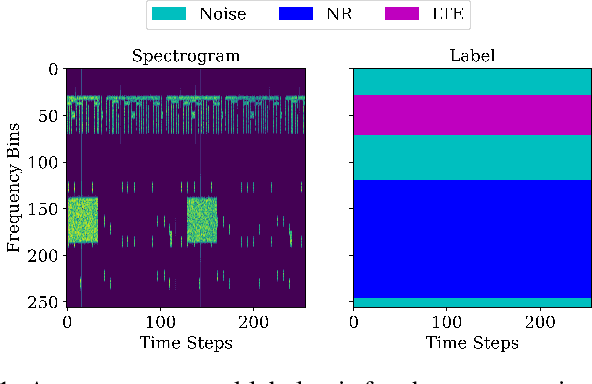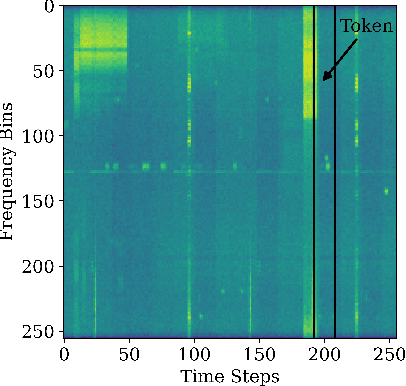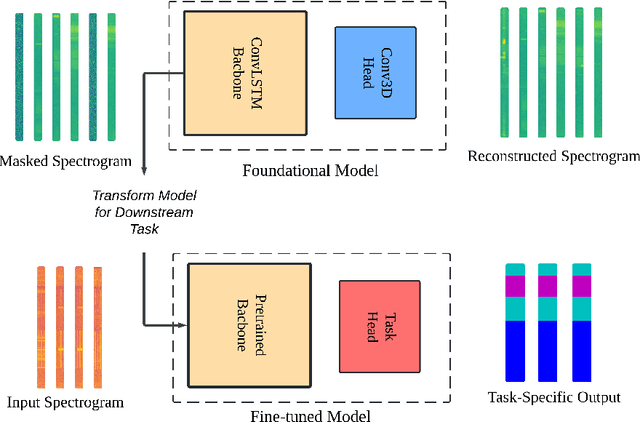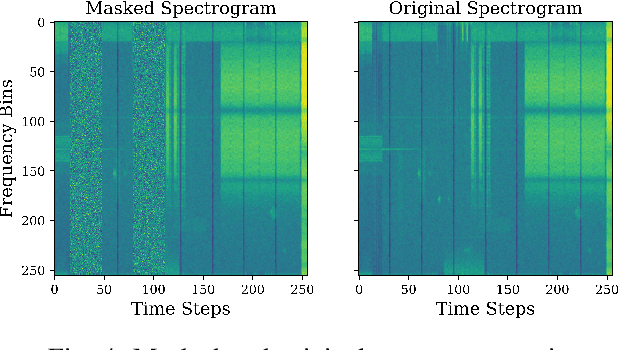Hatem Abou-Zeid
Adaptive Pareto-Optimal Token Merging for Edge Transformer Models in Semantic Communication
Sep 11, 2025Abstract:Large-scale transformer models have emerged as a powerful tool for semantic communication systems, enabling edge devices to extract rich representations for robust inference across noisy wireless channels. However, their substantial computational demands remain a major barrier to practical deployment in resource-constrained 6G networks. In this paper, we present a training-free framework for adaptive token merging in pretrained vision transformers to jointly reduce inference time and transmission resource usage. We formulate the selection of per-layer merging proportions as a multi-objective optimization problem to balance accuracy and computational cost. We employ Gaussian process-based Bayesian optimization to construct a Pareto frontier of optimal configurations, enabling flexible runtime adaptation to dynamic application requirements and channel conditions. Extensive experiments demonstrate that our method consistently outperforms other baselines and achieves significant reductions in floating-point operations while maintaining competitive accuracy across a wide range of signal-to-noise ratio (SNR) conditions. Additional results highlight the effectiveness of adaptive policies that adjust merging aggressiveness in response to channel quality, providing a practical mechanism to trade off latency and semantic fidelity on demand. These findings establish a scalable and efficient approach for deploying transformer-based semantic communication in future edge intelligence systems.
IQFM A Wireless Foundational Model for I/Q Streams in AI-Native 6G
Jun 07, 2025Abstract:Foundational models have shown remarkable potential in natural language processing and computer vision, yet remain in their infancy in wireless communications. While a few efforts have explored image-based modalities such as channel state information (CSI) and frequency spectrograms, foundational models that operate directly on raw IQ data remain largely unexplored. This paper presents, IQFM, the first I/Q signal foundational model for wireless communications. IQFM supporting diverse tasks: modulation classification, angle-of-arrival (AoA), beam prediction, and RF fingerprinting, without heavy preprocessing or handcrafted features. We also introduce a task-aware augmentation strategy that categorizes transformations into core augmentations, such as cyclic time shifting, and task-specific augmentations. This strategy forms the basis for structured, task-dependent representation learning within a contrastive self-supervised learning (SSL) framework. Using this strategy, the lightweight encoder, pre-trained via SSL on over-the-air multi-antenna IQ data, achieves up to 99.67% and 65.45% accuracy on modulation and AoA classification, respectively, using only one labeled sample per class, outperforming supervised baselines by up to 7x and 145x. The model also generalizes to out-of-distribution tasks; when adapted to new tasks using only 500 samples per class and minimal parameter updates via LoRA, the same frozen encoder achieves 94.15% on beam prediction (vs. 89.53% supervised), 50.00% on RML2016a modulation classification (vs. 49.30%), and 96.05% on RF fingerprinting (vs. 96.64%). These results demonstrate the potential of raw IQ-based foundational models as efficient, reusable encoders for multi-task learning in AI-native 6G systems.
6G WavesFM: A Foundation Model for Sensing, Communication, and Localization
Apr 18, 2025



Abstract:This paper introduces WavesFM, a novel Wireless Foundation Model (WFM) framework, capable of supporting a wide array of communication, sensing, and localization tasks. Our proposed architecture combines a shared Vision Transformer (ViT) backbone with task-specific multi-layer perceptron (MLP) heads and incorporates Low-Rank Adaptation (LoRA) for parameter-efficient fine-tuning. This design promotes full parameter sharing across tasks, significantly reducing the computational and memory footprint without sacrificing performance. The model processes both image-like wireless modalities, such as spectrograms and channel state information (CSI), and in-phase and quadrature (IQ) signals arranged as orthogonal frequency-division multiplexing (OFDM) resource grids. We demonstrate the strong generalization capabilities of WavesFM through extensive experiments on four downstream tasks: Fifth Generation New Radio (5G NR) positioning; multiple-input multiple-output OFDM (MIMO-OFDM) channel estimation; human activity sensing; and radio-frequency (RF) signal classification. Compared to supervised baselines trained individually, our approach achieves superior performance while sharing 80% of its parameters across tasks. Furthermore, we show that pretraining on domain-relevant data not only boosts performance but also accelerates convergence, reducing training time by up to 5x. These results demonstrate that our unified WFM can support diverse tasks and deliver significant gains in both performance and efficiency, highlighting the transformative potential of foundation models to drive AI-native paradigms in future sixth-generation (6G) networks.
SafeSlice: Enabling SLA-Compliant O-RAN Slicing via Safe Deep Reinforcement Learning
Mar 17, 2025Abstract:Deep reinforcement learning (DRL)-based slicing policies have shown significant success in simulated environments but face challenges in physical systems such as open radio access networks (O-RANs) due to simulation-to-reality gaps. These policies often lack safety guarantees to ensure compliance with service level agreements (SLAs), such as the strict latency requirements of immersive applications. As a result, a deployed DRL slicing agent may make resource allocation (RA) decisions that degrade system performance, particularly in previously unseen scenarios. Real-world immersive applications require maintaining SLA constraints throughout deployment to prevent risky DRL exploration. In this paper, we propose SafeSlice to address both the cumulative (trajectory-wise) and instantaneous (state-wise) latency constraints of O-RAN slices. We incorporate the cumulative constraints by designing a sigmoid-based risk-sensitive reward function that reflects the slices' latency requirements. Moreover, we build a supervised learning cost model as part of a safety layer that projects the slicing agent's RA actions to the nearest safe actions, fulfilling instantaneous constraints. We conduct an exhaustive experiment that supports multiple services, including real virtual reality (VR) gaming traffic, to investigate the performance of SafeSlice under extreme and changing deployment conditions. SafeSlice achieves reductions of up to 83.23% in average cumulative latency, 93.24% in instantaneous latency violations, and 22.13% in resource consumption compared to the baselines. The results also indicate SafeSlice's robustness to changing the threshold configurations of latency constraints, a vital deployment scenario that will be realized by the O-RAN paradigm to empower mobile network operators (MNOs).
Intelligent Spectrum Sharing in Integrated TN-NTNs: A Hierarchical Deep Reinforcement Learning Approach
Mar 09, 2025Abstract:Integrating non-terrestrial networks (NTNs) with terrestrial networks (TNs) is key to enhancing coverage, capacity, and reliability in future wireless communications. However, the multi-tier, heterogeneous architecture of these integrated TN-NTNs introduces complex challenges in spectrum sharing and interference management. Conventional optimization approaches struggle to handle the high-dimensional decision space and dynamic nature of these networks. This paper proposes a novel hierarchical deep reinforcement learning (HDRL) framework to address these challenges and enable intelligent spectrum sharing. The proposed framework leverages the inherent hierarchy of the network, with separate policies for each tier, to learn and optimize spectrum allocation decisions at different timescales and levels of abstraction. By decomposing the complex spectrum sharing problem into manageable sub-tasks and allowing for efficient coordination among the tiers, the HDRL approach offers a scalable and adaptive solution for spectrum management in future TN-NTNs. Simulation results demonstrate the superior performance of the proposed framework compared to traditional approaches, highlighting its potential to enhance spectral efficiency and network capacity in dynamic, multi-tier environments.
Computation Offloading Strategies in Integrated Terrestrial and Non-Terrestrial Networks
Feb 21, 2025Abstract:The rapid growth of computation-intensive applications like augmented reality, autonomous driving, remote healthcare, and smart cities has exposed the limitations of traditional terrestrial networks, particularly in terms of inadequate coverage, limited capacity, and high latency in remote areas. This chapter explores how integrated terrestrial and non-terrestrial networks (IT-NTNs) can address these challenges and enable efficient computation offloading. We examine mobile edge computing (MEC) and its evolution toward multiple-access edge computing, highlighting the critical role computation offloading plays for resource-constrained devices. We then discuss the architecture of IT-NTNs, focusing on how terrestrial base stations, unmanned aerial vehicles (UAVs), high-altitude platforms (HAPs), and LEO satellites work together to deliver ubiquitous connectivity. Furthermore, we analyze various computation offloading strategies, including edge, cloud, and hybrid offloading, outlining their strengths and weaknesses. Key enabling technologies such as NOMA, mmWave/THz communication, and reconfigurable intelligent surfaces (RIS) are also explored as essential components of existing algorithms for resource allocation, task offloading decisions, and mobility management. Finally, we conclude by highlighting the transformative impact of computation offloading in IT-NTNs across diverse application areas and discuss key challenges and future research directions, emphasizing the potential of these networks to revolutionize communication and computation paradigms.
ProtoBeam: Generalizing Deep Beam Prediction to Unseen Antennas using Prototypical Networks
Jan 06, 2025



Abstract:Deep learning techniques have recently emerged to efficiently manage mmWave beam transmissions without requiring time consuming beam sweeping strategies. A fundamental challenge in these methods is their dependency on hardware-specific training data and their limited ability to generalize. Large drops in performance are reported in literature when DL models trained in one antenna environment are applied in another. This paper proposes the application of Prototypical Networks to address this challenge and utilizes the DeepBeam real-world dataset to validate the developed solutions. Prototypical Networks excel in extracting features to establish class-specific prototypes during the training, resulting in precise embeddings that encapsulate the defining features of the data. We demonstrate the effectiveness of PN to enable generalization of deep beam predictors across unseen antennas. Our approach, which integrates data normalization and prototype normalization with the PN, achieves an average beam classification accuracy of 74.11 percent when trained and tested on different antenna datasets. This is an improvement of 398 percent compared to baseline performances reported in literature that do not account for such domain shifts. To the best of our knowledge, this work represents the first demonstration of the value of Prototypical Networks for domain adaptation in wireless networks, providing a foundation for future research in this area.
Building 6G Radio Foundation Models with Transformer Architectures
Nov 15, 2024Abstract:Foundation deep learning (DL) models are general models, designed to learn general, robust and adaptable representations of their target modality, enabling finetuning across a range of downstream tasks. These models are pretrained on large, unlabeled datasets using self-supervised learning (SSL). Foundation models have demonstrated better generalization than traditional supervised approaches, a critical requirement for wireless communications where the dynamic environment demands model adaptability. In this work, we propose and demonstrate the effectiveness of a Vision Transformer (ViT) as a radio foundation model for spectrogram learning. We introduce a Masked Spectrogram Modeling (MSM) approach to pretrain the ViT in a self-supervised fashion. We evaluate the ViT-based foundation model on two downstream tasks: Channel State Information (CSI)-based Human Activity sensing and Spectrogram Segmentation. Experimental results demonstrate competitive performance to supervised training while generalizing across diverse domains. Notably, the pretrained ViT model outperforms a four-times larger model that is trained from scratch on the spectrogram segmentation task, while requiring significantly less training time, and achieves competitive performance on the CSI-based human activity sensing task. This work demonstrates the effectiveness of ViT with MSM for pretraining as a promising technique for scalable foundation model development in future 6G networks.
Self-Supervised Radio Pre-training: Toward Foundational Models for Spectrogram Learning
Nov 14, 2024



Abstract:Foundational deep learning (DL) models are general models, trained on large, diverse, and unlabelled datasets, typically using self-supervised learning techniques have led to significant advancements especially in natural language processing. These pretrained models can be fine-tuned for related downstream tasks, offering faster development and reduced training costs, while often achieving improved performance. In this work, we introduce Masked Spectrogram Modeling, a novel self-supervised learning approach for pretraining foundational DL models on radio signals. Adopting a Convolutional LSTM architecture for efficient spatio-temporal processing, we pretrain the model with an unlabelled radio dataset collected from over-the-air measurements. Subsequently, the pretrained model is fine-tuned for two downstream tasks: spectrum forecasting and segmentation. Experimental results demonstrate that our methodology achieves competitive performance in both forecasting accuracy and segmentation, validating its effectiveness for developing foundational radio models.
Advancing IIoT with Over-the-Air Federated Learning: The Role of Iterative Magnitude Pruning
Mar 21, 2024



Abstract:The industrial Internet of Things (IIoT) under Industry 4.0 heralds an era of interconnected smart devices where data-driven insights and machine learning (ML) fuse to revolutionize manufacturing. A noteworthy development in IIoT is the integration of federated learning (FL), which addresses data privacy and security among devices. FL enables edge sensors, also known as peripheral intelligence units (PIUs) to learn and adapt using their data locally, without explicit sharing of confidential data, to facilitate a collaborative yet confidential learning process. However, the lower memory footprint and computational power of PIUs inherently require deep neural network (DNN) models that have a very compact size. Model compression techniques such as pruning can be used to reduce the size of DNN models by removing unnecessary connections that have little impact on the model's performance, thus making the models more suitable for the limited resources of PIUs. Targeting the notion of compact yet robust DNN models, we propose the integration of iterative magnitude pruning (IMP) of the DNN model being trained in an over-the-air FL (OTA-FL) environment for IIoT. We provide a tutorial overview and also present a case study of the effectiveness of IMP in OTA-FL for an IIoT environment. Finally, we present future directions for enhancing and optimizing these deep compression techniques further, aiming to push the boundaries of IIoT capabilities in acquiring compact yet robust and high-performing DNN models.
 Add to Chrome
Add to Chrome Add to Firefox
Add to Firefox Add to Edge
Add to Edge